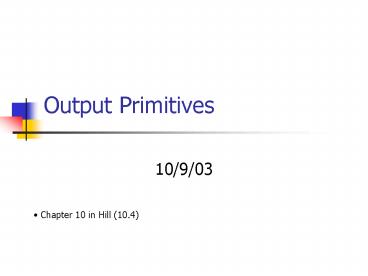Output Primitives - PowerPoint PPT Presentation
1 / 21
Title:
Output Primitives
Description:
into rectangular grid of pixels. E.g: straight line segments or polygon colour area ... It uses only integer value, avoid multiplication and has a ... – PowerPoint PPT presentation
Number of Views:40
Avg rating:3.0/5.0
Title: Output Primitives
1
Output Primitives
- 10/9/03
- Chapter 10 in Hill (10.4)
2
Introduction
What is it?
A basic geometric-structure specification that
can produce an object or a scene which being
map into rectangular grid of pixels. E.g
straight line segments or polygon colour
area Each output primitives is specified with
input coordinates with specific information
(intensity , color).
3
Introduction
- Point and straight line segments are the simplest
geometric - component of pictures
- 1. Point by converting single coordinate
- position into output device through
- application program.
- 2. Line by calculating the intermediate
- positions along two end-point.
4
Straight Line
- (Recall what you have learned before)
- Equation for straight line
- . y mx b
- . m slope
- . m is the changes in y divided by changes of x
- . m ?y / ?x
- . b the point where the line intercepts of y
axis.
5
Straight Line
- Let say we want to find the equation for
a line from (x1,y1) - to (x2,y2)
- . Slope
- . m ?y /?x
- . ?y y2-y1
- . ?x x2-x1
- . m y2-y1/x2-x1
- . y axis Intercept
- . b y1 m.x1
6
Straight Line
- The equation is used to
- a. Find the equation by two given points.
- b. Find the the b intercept by given equation.
- c. Find out whether line is parallel or
intercept at - which point.
7
OpenGL and output primitives
- OpenGL provides built-in tools or functions
to draw output - primitives. Even though this is done by
OpenGL, it is - important for us to know the underlying
fundamental that - is used to draw output primitives.
- In this section, we will look at the
algorithms used to draw - a straight line.
8
Line-Drawing Algorithm
1. Digital differential analyzer (DDA)
algorithm 2. Bresenhams line-drawing
algorithm
9
DDA Algorithm
Sample line at unit intervals on one axis and
calculate the corresponding co-ordinate on the
other axis. E.g. Line from (1,1) to (12,8) x1
1 and y1 1 x2 12 and y2 8
Algorithm (for slope 0 lt m lt 1) ?y 8 1 7
?x 12 1 11 m ?y / ?x 7/11 0.64
Plot the first point (1,1) For each x
co-ordinate between x 2 and x 12 y
co-ordinate previous y co-ordinate m
plot point at (x,y)
10
C Implementation of DDA
define ROUND (a) ((int) (a0.5)) void
plot_point(int x, int y) void line_DDA(int
x1,int y1,int x2, int y2) int dx,
dy, steps, k float x_increment, y_increment,
x, y if (abs(dx) gt abs(dy))
steps abs(dx) else steps
abs(dy) x_increment dx /
(float) steps y_increment dy / (float)
steps plot_point(ROUND(x), ROUND(y))
for (k0 klt steps k ) x
x_increment y y_increment
plot_point(ROUND(x), ROUND(y))
11
DDA Algorithm
12
DDA Algorithm
0 1 2 3 4 5 6
7 8 9 10 11 12
13
Observations
Advantages . Faster than using y mx b .
Eliminates multiplication (mx) by using screen
characteristics, i.e. incrementing
pixel. Disadvantages . Floating point
arithmetic is slower than integer arithmetic. .
Rounding down take time (fairly expensive
operation). . Long lines can drift from the true
line due to floating point round-off errors.
14
Bresenhams Algorithm
- Is a classic example of an incremental
algorithm that - computes the location of each pixel along a
line based on the - information about the previous pixel
- It uses only integer value, avoid
multiplication and has a - tight and efficient innermost loop that
generates the proper - pixels
15
Bresenhams Algorithm
- It has become the standard algorithm used in
hardware and - Software rasterizers
- Uses integer increment no rounding
- Decision parameter p used to decide which of two
pixels is - plotted (x1, y) or (x1, y1)
16
Implementation
1) Calculate ?x, ?y, 2?y,2?y-2?x . ?x 11,
?y 7 . 2?y 14 . 2?y - 2?x -8
2) Calculate initial p 2?y - ?x p 3
17
Implementation
- Plot the first point (1,1) (line between (1,1)
and (12, 8)) - For each x coordinate between x 2 and x 12
- If (p lt 0)
- y previous y
- p previous p 2?y
- else
- y previous y 1
- p previous p 2?y - 2?x
- plot point at(x,y)
18
C Implementation
Void line_bresenham(int x1, int y1, int x2, int
y2) Int dx,dy Int
two_dy 2 dy Int two_dy_dx 2
(dy-dx) Int p 2 dy dx Int
x, y, x_end If (x1 gt x2)
x x2 y y1 x_end
x1 else x x1
y y1 x_end x2
plot_point(x,y) (cont.)
19
C Implementation
while (x lt x_end) x
if plt0 p two_dy
else p two_dy_dx
y
plot_point(x,y)
20
Bresenhams Algorithm
Advantages . Accurate and efficient
incremental integer calculations . Can be
adapted to draw circles and curves.
21
Properties of a drawn line
- Point to take note when using algorithm to draw
straight line - The line drawn should be as straight as possible
and should - reliably pass through both of the given
endpoints - The line should be smooth and have uniform
brightness - along its length
- 3) The line should be drawn so that it is
repeatable - 4) The direction to draw the line from which
endpoint is not - important

